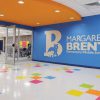Recent federal, state and local mandates have expanded school accountability measures beyond standardized test scores to include initiatives that address the interests and needs of the whole child. Recognizing this, Margaret Brent Elementary/Middle School is entering the next phase of its innovative, arts-integrated approach to teaching and learning in partnership with the Johns Hopkins School of Education.
Arts integration, using arts as a teaching tool, is a model for a holistic approach to teaching that encourages active learning, deep thinking and creative problem-solving. The programming is an outgrowth of a research study led by Dr. Mariale Hardiman, vice dean of the School of Education, and a team of researchers and curriculum specialists with the school’s Neuro-Education Initiative.
The study found that arts-infused teaching helps students retain information better than traditional teaching. “Students functioning at lower levels of reading achievement especially benefited from the arts-integrated approach,” she said.
The School of Education team, with the support of the Meyerhoff Foundation, shared the study’s arts-integrated units with science teachers at Margaret Brent and began training the school’s faculty in arts-integrated teaching strategies. Last year, an existing partnership between the School of Education and Margaret Brent expanded to include support from Homewood Community Partners Initiative (HCPI), a community development strategy comprised of 10 neighborhoods around the Johns Hopkins Homewood campus. The partnership provides coaching in arts integration and supports programming in the visual and performing arts offered during the day and after school, including instrumental music instruction through OrchKids and dramatic arts through Single Carrot Theater.
The mission of the partnership is to create a flagship program through a focus on the arts to transform school culture, improve pedagogy, foster engagement in learning and enrich learning experiences for all students. Teachers are the best advocates for their students’ needs, and Margaret Brent’s arts-integrated curriculum will exemplify how teacher leadership can be fostered in a public school setting.
The partnership has been widely supported by the Margaret Brent school leadership, faculty and community. One of the main activities within the Margaret Brent strategic plan was to identify the framework or theory of action that would shape the school’s flagship program. “After polling various stakeholders,” said Principal Pamela Smith, “it was decided that Margaret Brent would adopt an arts-integration approach to teaching, learning and assessing.”
Smith said that given the natural diversity of Margaret Brent, arts-integrated approach attracted a number of local artists and art organizations, ensuring that the arts were present in the life of the school.
Facilitating the partnership are Clare Grizzard, NEI arts-integration specialist; Carolyn Freeland, JHU Community Schools Consultant; Joe Meredith and Kathleen Mazurek, both of the School of Education, and Rachel Barillari, Margaret Brent’s arts-integration committee chair.
“The ultimate goal is to break the cycle of inequitable access to arts programming,” said Hardiman, “and to view arts-integration as one more tool in our work to achieve academic success for all students.”
For more information on how the arts support learning, follow the links below:
Hardiman, M. (2016). “Education and the Arts: Educating Every Child in the Spirit of Inquiry and Joy” Creative Education. 7, 1913-1928.
Hardiman, Rinne, Yarmolinskaya. (2014). “The Effects of Arts Integration on Long-Term Retention of Academic Content.” Mind, Brain, and Education. Vol. 8, Issue 3. 144-148.
Hardiman, M. (2009). “Commentary: The Arts Will Help School Accountability.” The Dana Foundation. www.centralbaltimore.org

